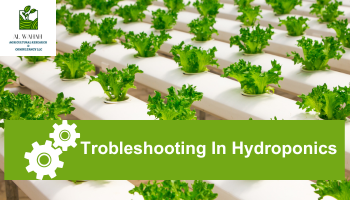Hydroponic growing can be relatively complicated only because of the technique, but when issues with your plants occur, this might be a major issue. Here, we’ll go through some of the most typical issues that can hinder your growth so you can fix them and stay clear of them in the future.
In This Article
• PH related problems
• Pest
• Water
• Overuse of nutrients
• Distance to light-sources
• Root bound
• Algae
• Mold
• Fungus
pH Related Problems
If you give your plants the correct care and attention and yet see some sickly symptoms, the issue is probably pH-related. Here are a few symptoms linked to pH: Even when adequately nourished, leaves might burn, distort, and stop growing altogether. Yellow spots can also appear. By using a pH metre to measure the water solution’s pH and a pH adjustor, which are both readily available at most plant stores, it is simple to resolve pH issues. One of the simplest conditions to diagnose and handle is pH-related issues. All hydroponic growers should always have at least one PH tester on hand when using hydroponic systems for plant growth.
Pest
There are many different kinds of pests that can completely ruin your crop, it is imperative to know how to spot a pest problem and if you have one and how to eliminate it. I recommended checking every plant really well at least 1-2 times a week. Especially underneath the foliage, this is where pests usually thrive. It is relatively easy to spot any kind of bug infestation, The usually signs are little holes on the leaves, pieces of leaves missing, webs seen from leaf to leaf, and obviously the bugs themselves being seen. If checked thoroughly and regularly you can spot any bugs on your plants and deal with accordingly before it becomes a problem.

There are numerous ways to deal with this problem. Among The most effective are purchasing an organic pest control spray for plants, can be found at almost every plant nursery and grow store… Another method is spraying your plants down with a 10-20% neem oil/water mix in a spray bottle and Spray the entire plant down. And a really good home remedy that works very well is mixing a dab of plain dish soap in a spray bottle, fill with water and spray thoroughly, making sure underneath the leaves are adequately
sprayed. Come back in 1-2 hours and rinse off with plain water.
You can also use insecticides and pesticides to control and tackle the pest problem – it is not the best solution hough. First, all pesticides are toxic (despite whatever the manufacturer claims) and second, pests develop a tolerance toward pesticides. So, what do we do?
We can introduce other insects that are predators of our pests. It may sound crazy to you but that is how the food chain works in the real world. The population of these predators depends on food availability; so as your pests dwindle in number, so do your predators.
You can also use insect traps (sticky papers); you can buy them or make them. To make them, cut out cardboard strips, paint them with any color you want; allow them to dry completely. Now, apply Vaselineor any petroleum jelly; use these strips for every 3 to 4 sq. feet of garden area.
Water
When plants are over watered they will quickly start to develop root rot, which can quickly spiral out of control before you may even know there is a problem. This could lead to a plant to stop producing new leaves. These are the main signs of overwatering:
wilting of the leaves and roots will become brow and mushy and stick a bit. Signs of under watering: leaves will start to drop dramatically and eventually dry up. To correct these problems simple give less or more water. A little tip to remember is that it is always better for a plant to receive less water than more.
Over Use of Nutrients
This is maybe the most common problem when using hydroponics, the signs include: “burning” of the leaves, leaves cupping inwards, and sometimes a copper color spotting will appear. When this happens simply change out your reservoir and use straight water for a few days then re-apply nutrients and check PH levels. When using hydroponic nutrients you must be very careful when measuring the amount to put into your reservoir, follow the recommended feeding schedule for your nutrients exactly, or less. All nutrients should have directions of use on the label somewhere.
Distance to Light Sources
This common problem is can be spotted by the outer parts of your leaves closest to the light turning a brown color and eventually warping. If your hand gets hot when you put under the light, then you know it’s too close and move up accordingly. Now on the other hand, when plants are too far from a light source or the light output is not enough the symptoms are very obvious. Your plants will tent to “stretch” towards the light, basically bending and elongating itself. Lights being too far will also cause very slow growth and eventually cause growth to stop completely, even if you would move your plants into abundant light they would not recover.
Root Bound
This is spotted by slow growth and roots appearing to come from the top of your hydroponic system. This can easily be detected and corrected by simply making sure you hydroponic system has enough room for roots and checking roots weekly to make sure they have more than enough space. You would be surprised on how fast they can grow and expand.
Algae
This is common among almost all hydroponic growers, and can be seen inside of tubing and all inside of your reservoir. The cause of this is sunlight exposure. To prevent this problem try to shield as much as your system and its irrigation tubing, as possible with a
reflective material. Reflective tape does very well at this. Another way to prevent algae growth is too regularly clean your hydroponic reservoir and tubing at least every few weeks. Doing this and securing any light leaks will ensure you will not develop algae.
Mold
Mold is usually a common problem when growing indoors is that it is closed environment. Mold is usually caused by too much moisture in the air, and/or not enough air circulating throughout your growing area. The signs are a white substance build up on
your growing medium and on the plant itself. When you have mold the first thing to do would be to check the humidity with a hydrometer and check if the humidity levels are normal. Next I would check and see if your ventilation fans are properly circulation
air, it is always good to have at least 1-2 fans for exhausting air out the room, 1-2 fans drawing in fresh air, and 1-3 fans blowing directly on your plants. Make sure all these requirements are meet and your mold problem should be a thing of the past.
Fungus
Fungi can grow at any time in anyone’s garden without any signs or anything before hand. It can cause serious problems for you plants such as producing diseases, rust, and mildew. The signs of fungi are immediately apparent as being whitish spots, leaves appearing to have white powder on them and leaves turning brown and soft. There are basically 2 different types of actions to deal with this: non-organic fungicides stated as “safe” but contain harmful chemicals to humans and animals. And there is organic home remedies’. Try using some of these simple methods get rid of fungi. Neem air is a great deterrent of fungus. The only thing is that you have to keep reapplying every other day till the problem is gone. Another great idea is a coffee solution mixture, Do 1 part all black coffee to 10 parts water. Mix all this in a bottle and spray. One more solution that is proven to have results is one tablespoon of baking soda per gallon of water, a dab of dish detergent and just a drop of vegetable oil. Spray this solution thoroughly over your plants.
Reference: Hydroponics101 A complete guide by Agnes Williams





